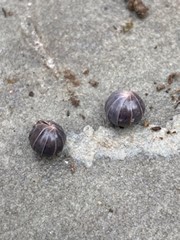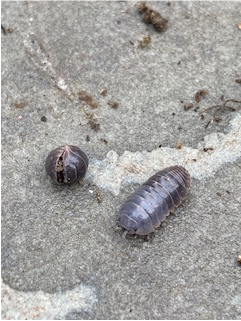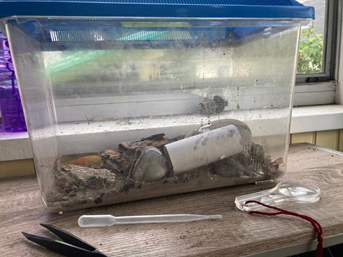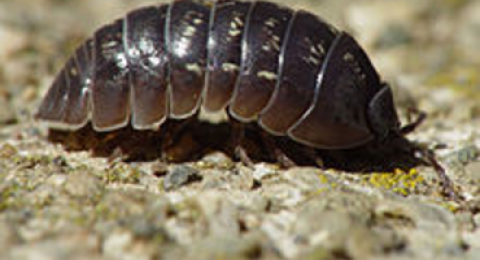One of the many subjects that ecologists investigate is how living things interact with their environment. One way we can study ecology is by exploring natural habitats. Pillbugs (roly-polies) provide an interactive opportunity to learn about ecological concepts in your own backyard or community.
A fun activity to do with children outside is to turn over rocks, logs and leaf litter. Observing with them and asking them what they see is a great start to a science investigation.
If you haven’t done this before or have a moment go lift something up in your yard— a rock, log, patio stone, garbage can— anything that could be a hiding place for small creatures.
Anything new and different? Creepy crawlies? Dead grass? Soil? Grains of sand? You probably saw a lot of little creatures scurrying away, maybe some plant roots, soil or perhaps a salamander, if you were lucky.
One of the little creatures you may see is a pillbug. The pillbug is a harmless, easy to find and take care of and allows for scientific observation and investigations.


When studying ecology, we are looking at how living things interact with the other living and non-living things in the world around them. We examine how animals are affected by light, moisture, and temperature (non-living things). We also look at interactions between organisms like predation or competition (living things). These interactions can occur between species and within species. For example, a pillbug may compete with other pillbugs for the best rotten leaf pile in your backyard. It also might be eaten by predators such as a spider, frog, shrew or mole.
Organisms have many adaptations to help them survive competition and predation, including where they live, when they are most active or how they handle cold or hot weather. Pillbugs have very interesting adaptations.
Pillbugs have adapted to live on land. They burrow into the soil and live under rocks and woody debris. They choose habitats that are dark and damp to stay moist and to avoid dry air or extreme temperatures. They are also nocturnal and huddle with other pillbugs to stay warm. In the food web, pillbugs are detritivores, which means they eat dead organic material.
The pillbug can be mistaken for another terrestrial isopod called a sowbug, but they differ in one way—what they do when they get threatened. One rolls up, hence the name roly poly, and one runs away because its body does not allow it to roll up.
If you would like to learn more about pillbugs and sowbugs, there are some great websites out there. For now, let’s get onto our investigation! The suggestions below are intended for youth in grades 3-5, however, they can be adapted for younger and older audiences.
The very first thing we’ll do is go outside and observe the pillbugs in their natural habitat. Using the information written above, think about where you might find them—dark, moist places where there is dead material, like rotting leaves, wood or plants. They are harmless and cannot hurt us, however, we can unintentionally harm them. Use a popsicle or craft stick to move leaves, debris or soil around. Use plastic spoons to pick them up, staying close to the ground if they fall off. In this first observation, ask youth to record the following information:


Habitat: Where did you find the pillbug? What was the temperature like there? Was it wet or dry? What was it like in the pillbug’s habitat that is different than the surface of the ground?
Interactions: Were there other living things near the pillbug? Were they huddled in a group? How is it interacting with other things? Were there other insects present?
Once back inside, you can locate more information about pillbugs to spark a discussion for youth and to generate questions they may have about pillbugs to investigate. Record their questions on a piece of paper that will be used later. Some questions may be hard to investigate with time and material restraints or could be harmful to the pillbug. These questions can be weeded out, researched or turned into investigable ones (see Extension's Inquiry Teaching Methods Course for more information!). Some great questions that would be hard to investigate include:
How long do pillbugs live for?
What eats pillbugs?
Why do pillbugs live under rocks?
Examples of questions that can be investigated would look like this:
Do pillbugs prefer dark or light places to live?
If given a choice of dirt or paper, where does the pillbug prefer to go to?
Are pillbugs threatened by other pillbugs or sowbugs? What do they do when I put other organisms into their habitat?
Now that students have made observations, generated questions and learned more about pillbug biology, we can move on to more investigations. Depending on your budget, time and how many youth you are working with, investigations can take many different routes.
In order to do investigations over several days, you may want to build your own pillbug habitat to encourage a colony to form. A habitat consists of a container with a lid that has small air holes poked through. The habitat should be kept in a cool dark place away from direct sunlight.


Cover the bottom of the container with sand on one side and soil on the other. To keep moisture in the habitat, keep a damp paper towel folded up on the bottom. Be sure to wet the paper towel each day. Then add natural materials that would typically be found where pillbugs live. This would include rocks, bark, twigs and leaves. You can add carrot shavings and lettuce to the sandy side of the habitat for food. Now it’s time to add your pillbugs! Head outside with your popsicle stick and plastic spoon to collect the pillbugs.
Afteryou have a new colony of pillbugs, you can begin conducting investigations into their behavior. Look back at the questions that were created earlier and decide which question you’d like to explore first. I’ll share an example below.
Scientific Question:
What do you want to find out? In your own words, describe the scientific question that the investigation seeks to answer.
Do pillbugs prefer to be in the dark or in the light?
Design:
Independent Variable:
The variable that you will change and how you will change it.
I will investigate my question by putting a cover over one side of a shoebox and leaving the other side of the lid open to the natural light.
Dependent Variable:
The response variable. The variable that you will observe as it responds to changes in the independent variable.
I will observe where the pillbugs prefer to be by counting the number of pillbugs on each side of the shoebox.
Constants:
What will remain the same?
The shoebox will have the same material on the bottom, soil. The shoebox will be in a cool place with natural light.
Materials needed:
Shoebox or Aquarium
Soil
Pillbugs (10)
Plastic spoon
Procedure:
What are the step-by-step activities? How will data be recorded? What will be the means of analysis?
- I will cover the bottom of shoebox with soil
- I will cover one half of the shoebox with black construction paper and tape it down
- I will record my data on a piece of paper with pictures and number of pillbugs on each side
- I will add the pillbugs into the center of the shoebox
- I will keep them in the shoebox for 10-15 minutes and see where they prefer to go
- I will repeat this with 10 different pillbugs
- I will put the pillbugs back in their habitat
Results: What did you find out?
Claim: The pillbugs prefer to be in light/dark because _________________________________
Evidence: From my investigation I learned that _________________________________________
Reason: This evidence supports my claim because _______________________________________
Other behaviors that are fun to investigation with pillbugs are
- Do pillbugs prefer moist or dry areas?
- How do pillbugs react to being cold (float a group of pillbugs in a Tupperware container in a bowl of ice and observe what they do)?
- What is the defense behavior of a pillbug compared to a sowbug? How do you tell the difference?
If you keep your colony of pillbugs for a long period of time you’ll begin to see molting, fecal matter and juveniles. You’ll even begin to observe what pillbugs do naturally like eating their own fecal matter or eating their own dead!
Pillbugs are such fascinating little creatures with many different adaptations and behaviors that bring wonder to children. Enjoy watching and investigating with these captivating creatures!
If you are interested in assessing learning during pillbug investigations, there are many Next Generation Science Standards (NGSS) science practices that students are using such as asking questions, designing investigations, creating models, engaging in argument from evidence, communication information and more. They are also learning key concepts about ecological interactions and biology. This resource connects to the NGSS through:
Standard 3-LS2 Ecosystems: Interactions, Energy and Dynamics
Performance Expectation: 3LS2-1
Construct an argument that some animals form groups that help members survive. Science and Engineering Practice: Engaging in Argument From Evidence
Disciplinary Core Idea: LS2.D: Social Interactions and Group Behavior
Crosscutting Concept: Cause and Effect
NGSS Table: 3-LS2 Ecosystems: Interactions, Energy, and Dynamics
www.nextgenscience.org/31s2-ecosystems-interactions-energy-dynamic
Suggested Internet Resources:
Carolina Biological Supply: www.Carolina.com
Featured Creatures: http://entnemdept.ufl.edu/creatures/MISC/Armadillidium_vulgare.htm
